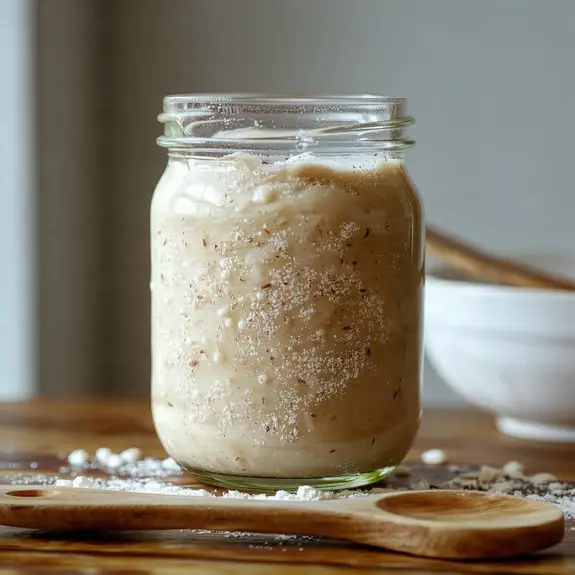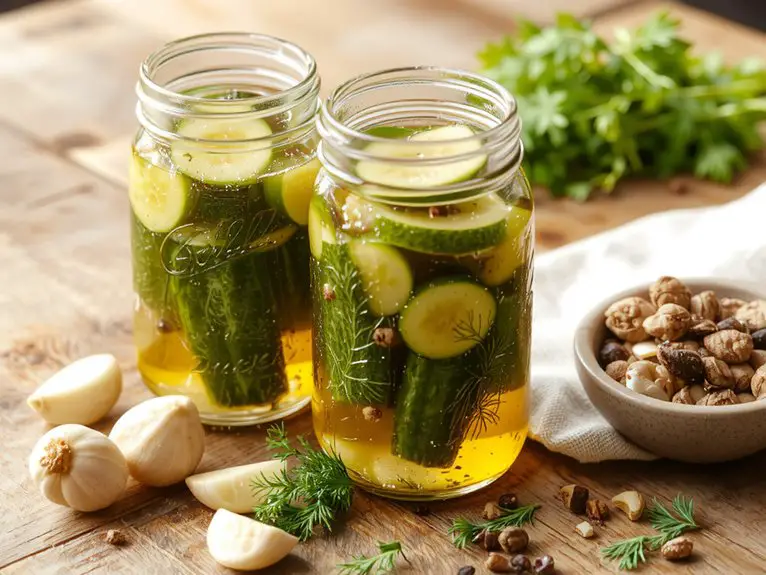Recipe
There’s nothing quite like the magic of sourdough—its tangy aroma, chewy texture, and golden crust are unmatched. This homemade sourdough starter recipe is your gateway to baking the most incredible loaves you’ve ever tasted, and I promise, it’s easier than you think.
All you need is flour, water, and a little patience to create a living, breathing culture that will transform your kitchen into a bakery. The beauty of sourdough lies in its simplicity; no fancy ingredients, just time and care.
Once you see those bubbles forming and smell that unmistakable tang, you’ll be hooked. Trust me, once you’ve baked with your own starter, store-bought bread just won’t compare. Let’s get started—your future sourdough adventures await!
Ingredients
When it comes to making a sourdough starter, simplicity is key. You only need two ingredients, but the quality and type you choose can make or break your starter’s success. Here’s what you’ll need and why each matters:
Flour
- Whole wheat flour (or rye flour): These flours are packed with wild yeast and bacteria, giving your starter a strong kickstart. Go for organic if available—it tends to have fewer additives that can hinder fermentation.
- All-purpose flour: Once your starter is established, switching to all-purpose flour creates a milder flavor. It’s less nutrient-dense, so it’s better for maintenance rather than initiation.
Water
– Filtered or bottled water****: Tap water often contains chlorine, which can kill the beneficial microbes your starter needs. Stick to water without additives for the best results.
Optional Boosters
- Unsweetened pineapple juice: A splash in the first few days can help lower the pH and give your starter a head start.
- Apple cider vinegar: Adds acidity to mimic the environment of a mature starter, speeding up the process.
Must-Have: Whole wheat or rye flour is non-negotiable for starting—they’re the powerhouse fuels your starter needs.
Pro Tip: If your starter smells off or struggles to rise, a small pinch of sugar can feed the yeast and get things moving again.
Substitutions: No whole wheat flour? Start with rye flour instead—it’s equally effective.
Little Wins: Using organic flour can elevate your starter’s flavor and consistency in the long run.
How to Make the Best Classic Sourdough Starter Method

Day 1:
– Mix 1/2 cup (60g) whole wheat flour and 1/4 cup (60ml) filtered water in a clean jar. Whole wheat flour contains more natural yeast and bacteria, giving your starter a strong start.
The mixture should look thick, like a paste.
- Scrape down the sides of the jar and loosely cover with a lid or cloth. Allowing airflow prevents mold, but covering it keeps contaminants out.
- Let it sit at room temperature (70–75°F or 21–24°C) for 24 hours. Warmer temperatures speed up fermentation, but consistency is key.
Day 2:
- Check for bubbles or a slightly sour smell. These are signs that fermentation has begun. If you see no activity, give it more time or move it to a warmer spot.
- Discard half of the starter (about 1/4 cup) and add 1/2 cup (60g) all-purpose flour and 1/4 cup (60ml) filtered water. Discarding prevents overgrowth and keeps the starter manageable.
Mix until smooth.
– Cover and let it sit for another 24 hours.
Day 3:
- Look for more bubbles and a tangy aroma. Your starter should be doubling in size within 6–8 hours after feeding.
- Discard half again and feed with 1/2 cup (60g) all-purpose flour and 1/4 cup (60ml) filtered water. Consistency is important—stick to the 1:1:1 ratio (starter:flour:water).
- Cover and let it sit for another 12 hours. At this stage, you may need to feed it twice daily for peak growth.
Days 4–7:
- Continue discarding and feeding every 12 hours. If your starter doubles in size within 4–6 hours and smells pleasantly sour, it’s ready to use.
- Switch to a 1:2:2 ratio (starter:flour:water) for a stronger starter. This reduces the acidity and improves flavor.
- Store your active starter in the fridge if not using daily. Feed it once a week to keep it healthy.
Pro Tips:
- Use a rubber band to mark the starter’s level after feeding—it’s easier to track growth.
- If liquid (hooch) forms on top, stir it back in or pour it off before feeding—it’s harmless but indicates hunger.
- Don’t panic if your starter smells like cheese or acetone—it’s normal during the early stages.
Watch-Out Warnings:
- Avoid using metal utensils or containers—they can react with the acidic starter.
- Don’t skip the discarding step—it prevents the starter from becoming too acidic or overflowing.
- If your starter smells rotten or shows mold, it’s best to start over.
Flexibility:
- If your kitchen is cooler, extend the fermentation time between feedings.
- You can adjust the hydration level for a thicker or thinner starter, depending on your recipe needs.
Nutrition
Sourdough starter is naturally rich in nutrients, offering a range of benefits for health-conscious bakers.
Below is the nutrition breakdown per tablespoon (about 15 grams) of sourdough starter.
Calories: 12
Carbohydrates: 2.5g
Protein: 0.5g
Fat: 0g
Fiber: 0.1g
Sugar: 0g
Chef Tips
Beyond its nutritional value, I’ve picked up a few tricks over the years to keep my sourdough starter thriving.
I always use non-chlorinated water and whole-grain flour for the initial mix. Feeding it at consistent times helps maintain its rhythm.
If it smells too acidic, I discard half and feed it more often. A warm spot boosts activity, while refrigeration slows it down for breaks.
Frequently Asked Questions
Can I Use Tap Water for My Sourdough Starter?
Yes, I can use tap water for my sourdough starter, but I’d let it sit overnight to let chlorine evaporate. If my water’s heavily treated, I might use filtered or bottled water to avoid disrupting the fermentation.
How Often Should I Feed My Sourdough Starter?
I feed my sourdough starter once a day if it’s kept at room temperature. If I store it in the fridge, I only feed it once a week to keep it alive but slow its growth.
What if My Sourdough Starter Smells Bad?
If my sourdough starter smells bad, I’ll check for mold or unusual colors. It might just need feeding if it’s overly acidic. I’ll discard most, refresh it, and see if the smell improves in a few feedings.
Can I Freeze My Sourdough Starter?
Yes, I can freeze my sourdough starter if I need to store it long-term. I’ll feed it first, let it peak, then freeze it in an airtight container. Thawing it slowly and feeding it revives it.
How Long Does a Sourdough Starter Last Without Feeding?
A sourdough starter can last about a week unfed if kept in the fridge. Beyond that, it’ll weaken or die. I’d recommend feeding it weekly to keep it active and strong for baking. Never leave it unfed too long.










